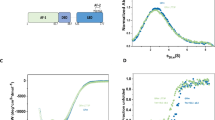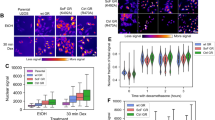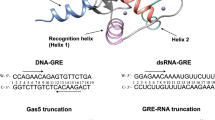Abstract
Steroid hormones are thought to modulate gene expression through their interaction with receptor proteins. The intracellular localization of unoccupied receptor proteins has been a subject of controversy: free glucocorticoid receptor appears to reside in the cytoplasm and moves to the cell nucleus only after binding the steroid1,2. The purified hormone-bound glucocorticoid receptor has been shown to bind selectively to hormone regulatory elements (HRE) in the vicinity of hormonally-inducible promoters and, in particular, in the long terminal repeat (LTR) region of mouse mammary tumour virus (MMTV)3,4. We have tackled the question of whether the hormone itself is required for the interaction of the receptor protein with the HRE. Using monoclonal antibodies to the receptor we find that upon heat-activation the steroid-free glucocorticoid receptor present in rat liver cytosol binds specifically in vitro to the HRE of MMTV. No qualitative differences in the DNaseI-footprints were detected when hormone-free receptor was compared to the hormone-receptor complex or even receptor complexed with the hormone antagonist RU486. We conclude that the steroid ligand is not an absolute requirement for generating the conformation of the glucocorticoid receptor that allows its interaction with the HRE in vitro. An alternative function of the hormone in vivo could be to modulate nuclear partitioning of the receptor.
This is a preview of subscription content, access via your institution
Access options
Subscribe to this journal
Receive 51 print issues and online access
$199.00 per year
only $3.90 per issue
Buy this article
- Purchase on Springer Link
- Instant access to full article PDF
Prices may be subject to local taxes which are calculated during checkout
Similar content being viewed by others
References
Fuxe, K. et al. Endocrinology 117, 1803–1812 (1985).
Antakly, T. & Eisen, H. J. Endocrinology 115, 1984–1989 (1984).
Payvar, F. et al. Cell 35, 381–392 (1983).
Scheidereit, C., Geisse, S., Westphal, H. M. & Beato, M. Nature 304, 749–752 (1983).
Beato, M. & Feigelson, P. J. biol. Chem. 247, 7890–7896 (1972).
Hynes, N. H. et al. Proc. natn. Sci. U.S.A. 80, 3637–3641 (1983).
Herrmann, W. et al. C.r. Acad. Sci. Paris 294, (III), 933–938 (1982).
Westphal, H. M., Moldenhauer, G. & Beato, M. EMBO J. 1, 1467–1471 (1982).
Idziorek, T. et al. Eur. J. Biochem. 153, 65–74 (1985).
Baxter, J. D. et al. Proc. natn. Acad. Sci. U.S.A. 69, 1892–1897 (1972).
Beato, M., Kalimi, M., Konstam, M. & Feigelson, P. Biochemistry 12, 3372–3379 (1973).
Bourgeois, S., Pfahl, M. & Baulieu, E. E. EMBO J. 3, 751–755 (1984).
Joab, I. et al. Nature 308, 850–853 (1984).
Tymoczko, J. L. & Phillips, M. Endocrinology 112, 142–149 (1983).
Kalderon, D., Roberts, B. L., Richardson, W. D. & Smith, A. E. Cell 39, 499–509 (1984).
Richardson, W. D., Roberts, B. L. & Smith, A. E. Cell 44, 77–85 (1986).
King, W. J. & Greene, G. L. Nature 307, 745–747 (1984).
Welshons, W. V., Liebermann, M. E. & Gorski, J. Nature 307, 747–749 (1984).
Maxam, A. M. & Gilbert, W. Meth. Enzymol. 5, 499–560 (1980).
Author information
Authors and Affiliations
Rights and permissions
About this article
Cite this article
Willmann, T., Beato, M. Steroid-free glucocorticoid receptor binds specifically to mouse mammary tumour virus DNA. Nature 324, 688–691 (1986). https://doi.org/10.1038/324688a0
Received:
Accepted:
Issue Date:
DOI: https://doi.org/10.1038/324688a0
This article is cited by
Comments
By submitting a comment you agree to abide by our Terms and Community Guidelines. If you find something abusive or that does not comply with our terms or guidelines please flag it as inappropriate.



